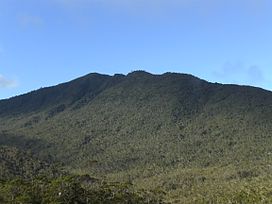| Mount Hamiguitan | |
|---|---|
 | |
| Highest point | |
| Elevation | 5,344 ft (1,629 m) |
| Prominence | 1,497 m (4,911 ft)[1] |
| Coordinates | 6°44′24″N 126°10′54″E / 6.74000°N 126.18167°E[1] |
| Naming | |
| Pronunciation | [hamiˈɡitan] |
| Geography | |
| Country | Philippines |
| Region | Davao Region |
| Province | Davao Oriental |
| City/municipality | |
| Parent range | Hamiguitan Mountain Range |
| Geology | |
| Mountain type | Stratovolcano |
| Official name | Mount Hamiguitan Range Wildlife Sanctuary |
| Type | Natural |
| Criteria | x |
| Designated | 2014 (38th session) |
| Reference no. | 1403 |
| Region | Asia and the Pacific |
Mount Hamiguitan is a mountain located in the province of Davao Oriental, Philippines. It has a height of 1,620 metres (5,315 ft). The mountain and its vicinity has one of the most diverse wildlife populations in the country. Among the wildlife found in the area are Philippine eagles and several species of Nepenthes. Some of the latter, such as the Nepenthes peltata and Nepenthes micramphora, are endemic to the area.[2][3] The mountain has a protected forest area of approximately 2,000 hectares. This woodland is noted for its unique pygmy forest of century-old trees in ultramafic soil, with many endangered, endemic and rare species of flora and fauna.[4][5]
The Mount Hamiguitan range, with an area of 6,834 hectares (68.34 km2), was declared a national park and a wildlife sanctuary in 2003.[6] In 2014, the park was inscribed as a UNESCO World Heritage Site, becoming the first in Mindanao and the sixth in the Philippines.[5]
Mount Hamiguitan is part of the Eastern Mindanao Biodiversity Corridor.[7] Conservation of the mountain range is a multisectoral effort done involving the provincial government of Davao Oriental, the Department of Environment and Natural Resources, local communities, and indigenous people.[8][9]
- ^ a b de Ferranti, Jonathan; Maizlish, Aaron (2005). "Philippine Mountains – 29 Mountain Summits with Prominence of 1,500 Meters or Greater". peaklist.org. Retrieved January 9, 2009.
- ^ "Nepenthes: Species in the Philippines". The Carnivorous Plant FAQ v. 11.5. The International Carnivorous Plant Society. 2009. Archived from the original on January 22, 2009. Retrieved January 9, 2009.
- ^ Amoroso, Victor B.; Aspiras, Reyno A. (2011). "Hamiguitan Range: A Sanctuary for Native Flora". Saudi Journal of Biological Sciences. 18 (1): 7–15. doi:10.1016/j.sjbs.2010.07.003. PMC 3730927. PMID 23961098.
- ^ "Davao Oriental Wants Hamiguitan Declared as World Heritage Site". GMA News Online. May 5, 2008. Archived from the original on March 10, 2011. Retrieved January 9, 2009.
- ^ a b "Nine New Sites Inscribed on World Heritage List". UNESCO. June 23, 2014. Archived from the original on June 25, 2014. Retrieved June 23, 2014.
- ^ Republic Act No. 9303 – via Supreme Court E-Library.
- ^ "Mount Hamiguitan Range Wildlife Sanctuary". UNESCO World Heritage Centre. Retrieved February 9, 2022.
- ^ Quismundo, Tarra (June 25, 2013). "Mt. Hamiguitan Being Considered as Unesco World Heritage Site". Inquirer.net. Retrieved December 1, 2020.
- ^ "Mount Hamiguitan Range Wildlife Sanctuary". IUCN World Heritage Outlook. Retrieved December 1, 2020.

